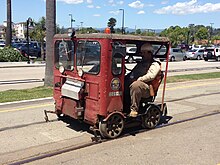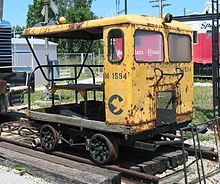
A speeder (also known as a section car, railway motor car, putt-putt, track-maintenance car, crew car, jigger, trike, quad, trolley, inspection car, or draisine) is a small railcar used around the world by track inspectors and work crews to move quickly to and from work sites. Although slow compared to a train or car, it is called speeder because it is faster than a human-powered vehicle such as a handcar. Motorized inspection cars date back to at least 1895, when the Kalamazoo Manufacturing Company started building gasoline-engined inspection cars.
In the 1990s, many speeders were replaced by pickup trucks or sport utility vehicles with additional flanged wheels that could be lowered for travelling on rails, called "road–rail vehicles" or hi-rails for "highway-railroad". Speeders are collected by hobbyists, who refurbish them for excursions organized by the North American Railcar Operators Association in the U.S. and Canada and the Australian Society of Section Car Operators, Inc. in Australia.
Motorcar manufacturers and models


| United States | Canada |
|---|---|
|
|
Various railways and their workshops also manufactured speeders. Often these were a copy of commercially available cars, such as Wickham and Fairmont.
Dimensions
Approximate dimensions of a common speeder car are given below. Due to the variety of base models and customization these are not fixed numbers. These values are from a Fairmont A4-D.
- Rail gauge: 1,435 mm (4 ft 8+1⁄2 in) standard gauge (56.5 inches)
- Weight: 3,500 pounds (1,588 kg)
- Width: 64 inches (1,626 mm)
- Height: 60 inches (1,524 mm)
- Length: 9 feet 2 inches (2,794 mm) (~110 inches)
- Wheel diameter: 16 inches (406 mm)
- Floor height: 80–120% of the wheel diameter; 11 inches (279 mm)-17 inches (432 mm)
Gallery
-
 Former Queensland Rail (Australia) speeders
Former Queensland Rail (Australia) speeders
-
 A former UK MOD railway engineering personnel carrier (Wickham trolley)
A former UK MOD railway engineering personnel carrier (Wickham trolley)
-
 Dort tourer modified by the South Australian Railways in the 1920s to be a motor inspection car
Dort tourer modified by the South Australian Railways in the 1920s to be a motor inspection car
-
 Russian GAZ-13 Chaika car converted to a speeder, preserved at the Hungarian Railway Museum
Russian GAZ-13 Chaika car converted to a speeder, preserved at the Hungarian Railway Museum
-
Deutsche Bundesbahn speeder based on the Volkswagen Type 2 light commercial vehicle
-
 A battery-powered ultrasonic rail flaw detector trolley made at the Centre For Advanced Transport Engineering and Research, Western Australia
A battery-powered ultrasonic rail flaw detector trolley made at the Centre For Advanced Transport Engineering and Research, Western Australia
See also
- Cater MetroTrolley
- Draisine
- Handcar
- North American Railcar Operators Association
- Railbus
- Railcar
- Road-rail vehicle
- The Railrodder
Notes
- Fairmont used three letters to designate car types. "S" was a Standard Series" section car; "A" was an "Advanced Series" section car and "M" was the "Master Series" section car. They also used a "category" name for motorcars. "Light Inspection" or 1-2 men, were car models: M9 nicknamed "Safe Easy", MM9, MR9, 59, M17, and MM17. "Inspection" or 1-4 men, were models "Roadmaster", M12, M16, M19 nicknamed the Safety Quick", MT19, and the 150. "Light Section" or 1-6 men, the M1, and M14 also called the "Light Section Car". "Section" or 1-8 men, were models "Dreadnaught", M2, 75, and S2. "Heavy Duty Section" or 1-8 men, the A2. "Gang" or 1-12 men, MT2, ST2, A2, AT2 and A3. "Extra Gang" or "B & B" 1-12 men, MX3, MX30G, MT2, A4, AF4, and A6. Final group, "Large Extra Gang" or "Hump" 1-12 men, models A6, A7, A8.
References
- "FAQ's & Answers". NARCOA. Retrieved 2008-01-25.
- "Miscellaneous items". The Neenah Daily Times. 28 June 1895. p. 2.
- NARCOA website
- A-4
External links
- Motorcars, Speeders & Handcars
- NARCOA
- CVRTC - New England Speeder Group
- Wickham of Ware Discussion Group